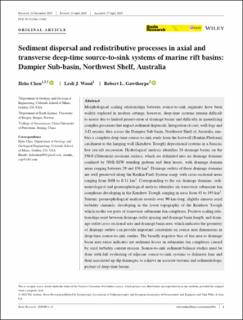| dc.contributor.author | Chen, Hehe | |
| dc.contributor.author | Wood, Lesli J. | |
| dc.contributor.author | Gawthorpe, Robert | |
| dc.date.accessioned | 2021-05-14T09:38:14Z | |
| dc.date.available | 2021-05-14T09:38:14Z | |
| dc.date.created | 2020-08-23T19:22:13Z | |
| dc.date.issued | 2021 | |
| dc.Published | Basin Research. 2020, 1-23. | |
| dc.identifier.issn | 0950-091X | |
| dc.identifier.uri | https://hdl.handle.net/11250/2755264 | |
| dc.description.abstract | Morphological scaling relationships between source‐to‐sink segments have been widely explored in modern settings, however, deep‐time systems remain difficult to assess due to limited preservation of drainage basins and difficulty in quantifying complex processes that impact sediment dispersals. Integration of core, well‐logs and 3‐D seismic data across the Dampier Sub‐basin, Northwest Shelf of Australia, enables a complete deep‐time source‐to‐sink study from the footwall (Rankin Platform) catchment to the hanging wall (Kendrew Trough) depositional systems in a Jurassic late syn‐rift succession. Hydrological analysis identifies 24 drainage basins on the J50.0 (Tithonian) erosional surface, which are delimited into six drainage domains confined by NNE‐SSW trending grabens and their horsts, with drainage domain areas ranging between 29 and 156 km2. Drainage outlets of these drainage domains are well preserved along the Rankin Fault System scarp, with cross‐sectional areas ranging from 0.08 to 0.31 km2. Corresponding to the six drainage domains, sedimentological and geomorphological analysis identifies six transverse submarine fan complexes developing in the Kendrew Trough, ranging in areas from 43 to 193 km2. Seismic geomorphological analysis reveals over 90‐km‐long, slightly sinuous axial turbidity channels, developing in the lower topography of the Kendrew Trough which erodes toe parts of transverse submarine fan complexes. Positive scaling relationships exist between drainage outlet spacing and drainage basin length, and drainage outlet cross‐sectional area and drainage basin area, which indicates the geometry of drainage outlets can provide important constraints on source area dimensions in deep‐time source‐to‐sink studies. The broadly negative bias of fan area to drainage basin area ratios indicates net sediment losses in submarine fan complexes caused by axial turbidity current erosion. Source‐to‐sink sediment balance studies must be done with full evaluating of adjacent source‐to‐sink systems to delineate fans and their associated up‐dip drainages, to achieve an accurate tectonic and sedimentologic picture of deep‐time basins. | en_US |
| dc.language.iso | eng | en_US |
| dc.publisher | Wiley | en_US |
| dc.rights | Navngivelse 4.0 Internasjonal | * |
| dc.rights.uri | http://creativecommons.org/licenses/by/4.0/deed.no | * |
| dc.title | Sediment dispersal and redistributive processes in axial and transverse deep-time source-to-sink systems of marine rift basins: Dampier Sub-basin, Northwest Shelf, Australia | en_US |
| dc.type | Journal article | en_US |
| dc.type | Peer reviewed | en_US |
| dc.description.version | publishedVersion | en_US |
| dc.rights.holder | Copyright 2020 the authors. | en_US |
| cristin.ispublished | true | |
| cristin.fulltext | original | |
| cristin.qualitycode | 2 | |
| dc.identifier.doi | 10.1111/bre.12462 | |
| dc.identifier.cristin | 1824673 | |
| dc.source.journal | Basin Research | en_US |
| dc.source.pagenumber | 227-249 | en_US |
| dc.identifier.citation | Basin Research. 2021, 33 (1), 227-249. | en_US |
| dc.source.volume | 33 | en_US |
| dc.source.issue | 1 | en_US |

